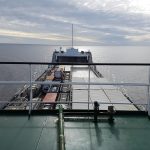Ship types included for MRV reporting
Offshore ships above 400 GT are required to start reporting GHG emissions from 1 January 2025.
The adopted Delegated Regulation (to be published by the end of 2024) amends the EU MRV Regulation 2015/757 stating that the following ships designed or certified to perform service activities offshore or at offshore installations should be considered offshore ships:
The ship’s statutory certifications or any other relevant documentation, including class notations, should be taken into consideration to determine whether the ship falls under the definition of an offshore ship or not.
DNV does not consider platforms and rigs, such as jack-ups and semi-submersible platforms, to fall under any of the ship types listed. Therefore, for such objects there is no need to prepare an MRV Monitoring Plan and start reporting. However, more guidance may be issued later specifying this list further.
Company responsible for the EU MRV Monitoring Plan
According to the MRV regulations, the registered owner is the company responsible, unless it has explicitly mandated the ISM company.
The company responsible should submit the Monitoring Plan to an accredited verifier for assessment and then to the company’s administering authority as soon as possible in time for the reporting period starting 1 January 2025.
EU ETS from 1 January 2027 (>5,000 GT)
Note that offshore ships of 5,000 GT and above will fall under the scope of the EU ETS from 1 January 2027, while ships of 400 GT and up to 5,000 GT will be reviewed by 31 December 2026 for inclusion at a later stage.
A company that is only responsible for offshore vessels (and not responsible for other ship types) does not need to open a Maritime Operator Holding Account, as the EU ETS does not apply to these ships before 2027.
Voyage-based reporting in the EU MRV
The inclusion of offshore ships in the EU MRV scheme from 2025 implies that each port of call and voyage must be monitored and reported. Reporting in regular intervals (such as every day at noon or at midnight) should be supplemented by reports documenting the start and end of a port call. In addition, emissions resulting from ship movements within a port of call should be monitored and reported. Relevant resources for reporting:
- For specific requirements related to reporting to DNV, we encourage you to visit our dedicated guidance page, see below under Resources, “Veracity’s OVD reporting resource page”.
- How to report shifting in port, see below under Resources, “How to report shifting in port for MRV”.
- How to report for offshore ships, see below under Resources: “How to report for offshore vessels”.
Port definition
The European Commission is expected to publish guidance related to stops at offshore facilities. Apart from port facilities ashore, which should naturally also be considered as a port in the context of the EU MRV Regulation, the following should be considered as a port:
- An offshore facility (such as an FPSO, FSRU) with an assigned UN/LOCODE
- An offshore facility located outside of the port but permanently connected to a port (such as loading buoys)
If an offshore ship stops at such a facility to load or unload cargo, embark or disembark passengers, or relieve crew, it will be considered a port of call under the EU MRV Regulation. Relevant resources:
How to report port calls, see below under Resources, “How to report port calls”
Definition of “port of call”
An MRV voyage is defined as being from one port of call to another port of call, and any activities carried out in between are considered part of the voyage.
For an offshore ship, if at least one of the following conditions are met, a stop in a port is considered a port of call:
- A port where the ship stops to load or unload cargo or to embark or disembark passengers
- A port where the ship stops to relieve the crew
In addition, ship-to-ship transfer within port limits is considered a port of call in the EU MRV Regulation. In the voyage scenario below, the MRV voyage A starts when ship’s crew embarks the vessel in a member state port. The vessel proceeds to a service area (e.g. offshore installation, project site, research area) to perform service activity and later returns to a member state port to relieve the crew. The MRV voyage covers the time from departure from port, the transit to service area, the service activity and the transit back to port until arrival in port.
Reporting of cargo carried
As per the Implementing Regulation (EU) 2016/1928, for ship types not falling under any of the defined categories of the regulation, cargo carried is determined as mass of cargo on board or as deadweight carried for laden voyages and zero for ballast voyages. Offshore ships should comply with this requirement and additionally monitor the number of passengers and crew members to determine the port-of-call status. Pending further guidance from the European Commission, we recommend that all personnel on board is reported as either passengers or crew members. Relevant monitoring procedures should be reflected in the ship’s MRV Monitoring Plan.




